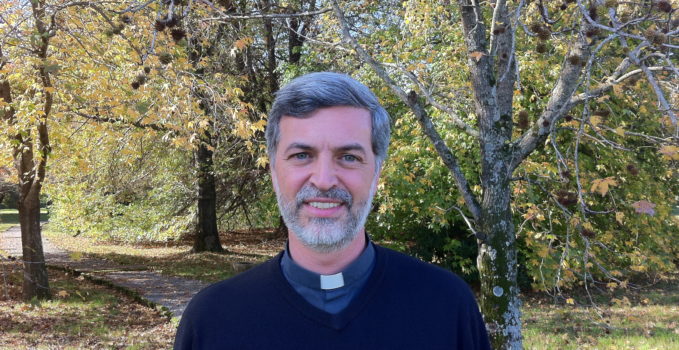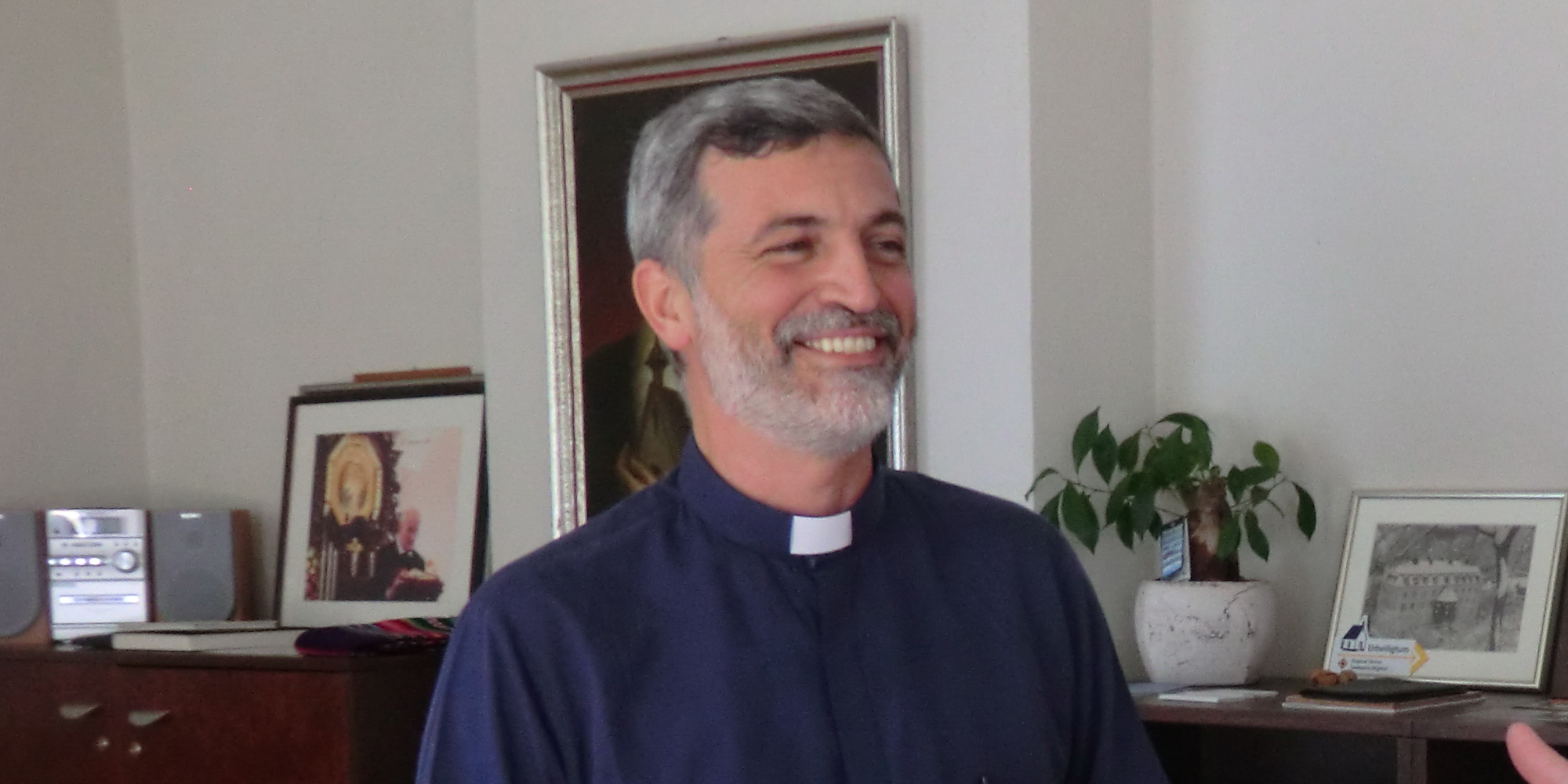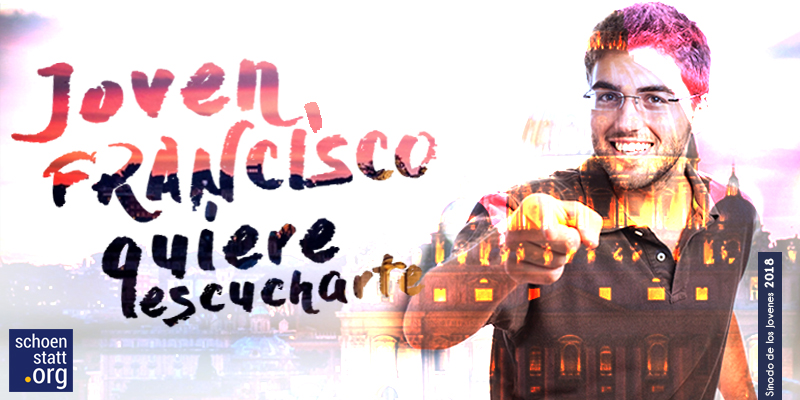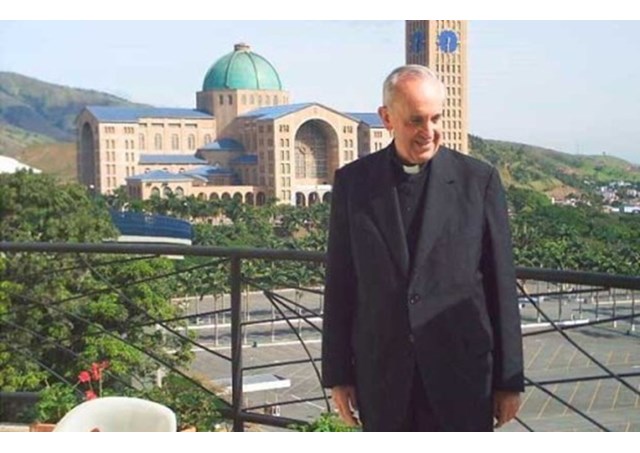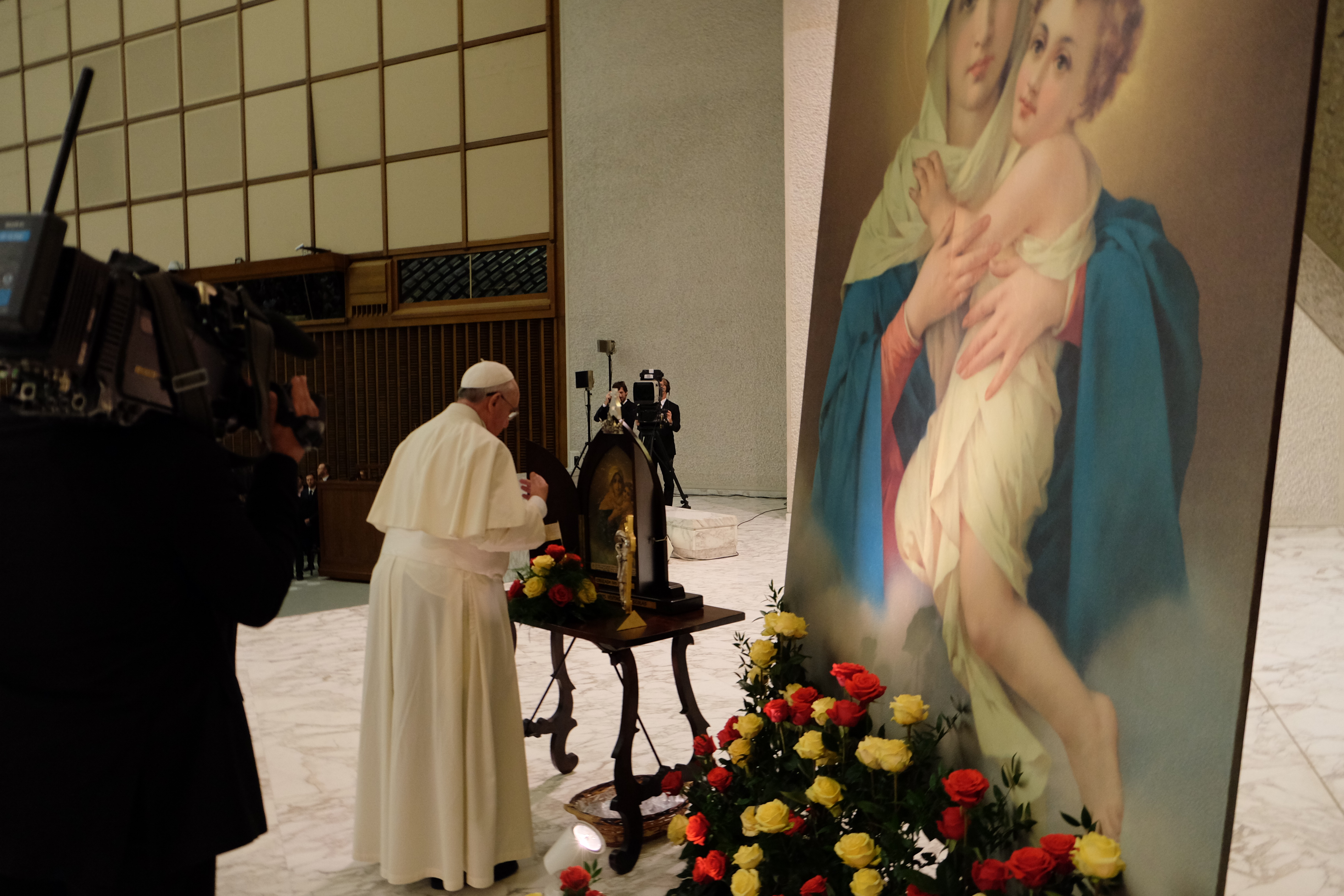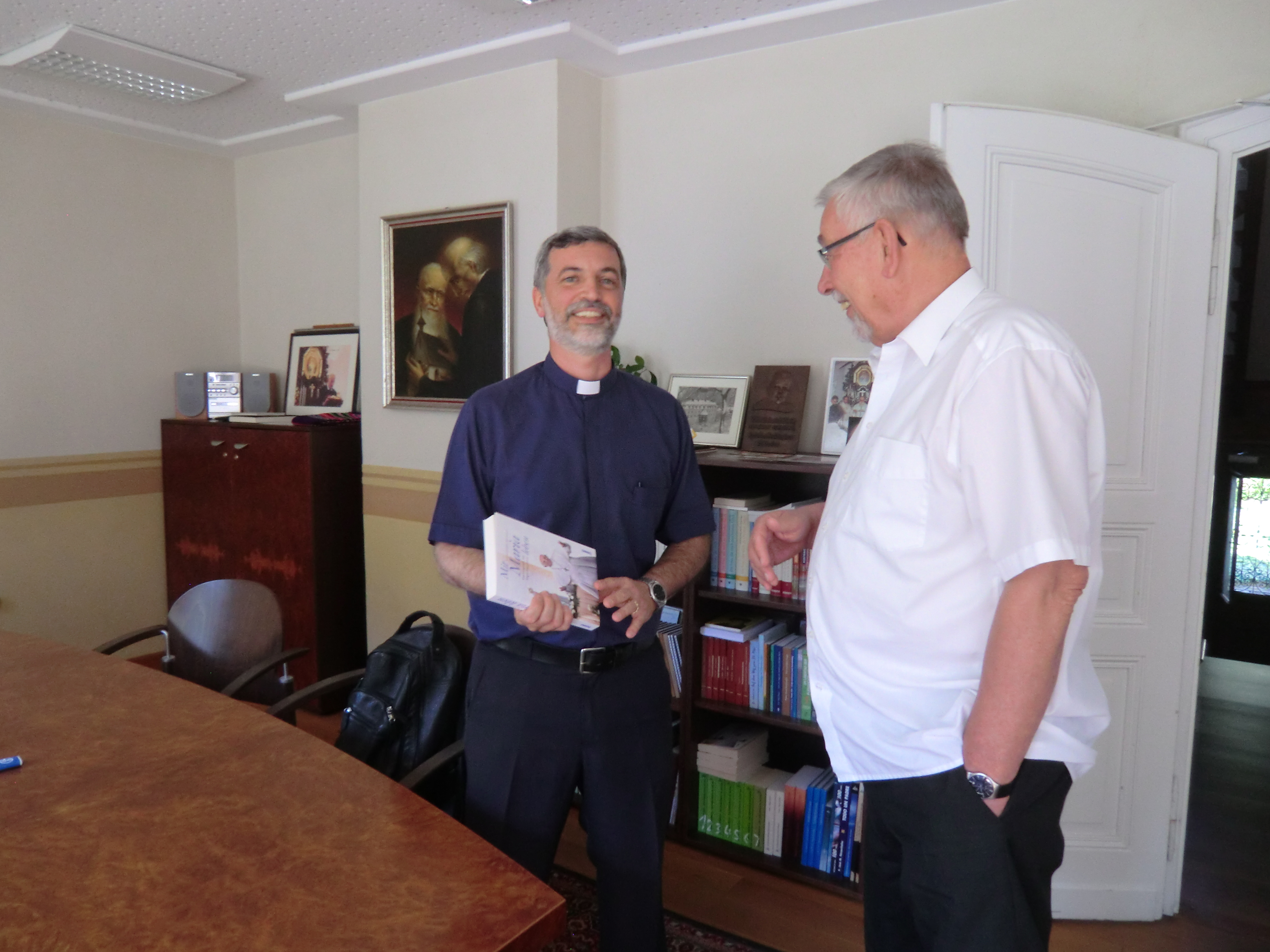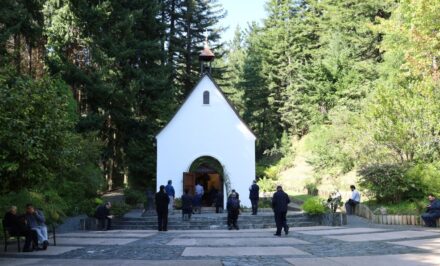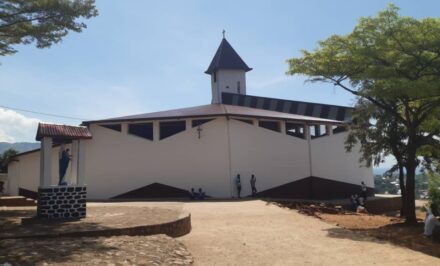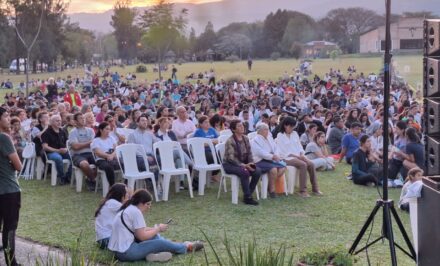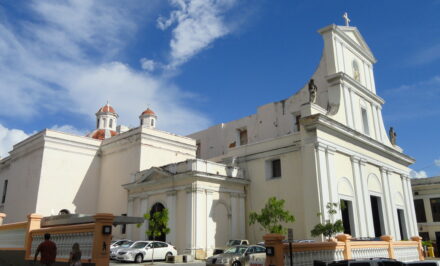SCHOENSTATTERS AT THE SERVICE OF THE CHURCH: Fr. Alexandre Awi, the new secretary for the Dicastery for Laity, Family and Life
On 1 September, Fr. Alexandre Awi, a Schoenstatt Father from Brazil, who up until May this year was the National Movement Director for Brazil, officially took up his task as the Secretary of the Dicastery for Laity, Family and Life. Before starting his new job and after having spent several months in the house of the Schoenstatt Fathers in Trastévere, Rome, where he finished his doctoral thesis and studied Italian, he went on pilgrimage to Schoenstatt, where we had the opportunity to interview him.
The date on which he undertakes his new role coincides providentially with the anniversary of the publication of the German translation of his book: “She is my mother,” on Pope Francis’ relationship with Mary. He took the opportunity to thank Fr. Egon Zillekens, who made the translation of the book into German possible through a fundraising initiative, and Maria Fischer for translating and getting it published by Editorial Benno. In the interview he gave on 29 August to the Schoenstatt.org editorial team, he spoke about — among other things — his new role, the preparations for the Youth Synod, which is undertaking the largest survey in the history of the Church, and the challenge of Dilexit Ecclesiam in this historic moment for the Church and Schoenstatt.
The venue for the interview was also significant: the room where Fr. Kentenich used to receive his guests. In this place, when he received the Pilgrim Mother that João Pozzobon sent him, Fr. Kentenich spoke about the “new pastoral work” that we seek and can find in João’s work. In this room there were also many conversations about the changes brought about by the post-conciliar Church and Schoenstatt’s contribution after ending a period of defending itself, profiling itself and guaranteeing its integrity and guiding itself towards Dilexit Ecclesium and service to the Church. On 14 September 1968 after dinner, Fr. Kentenich left this room and went to Mount Schoenstatt and on the morning of 15 September celebrated his last Mass before being called home to the Father.
1 – Fr. Alexandre, what exactly is this new dicastery and what will be your role in it?
Thank you for the opportunity to tell the Schoenstatt family about this new job, even though I don’t know too much abut it yet, since I am only starting and I have much to learn. The dicastery itself is new, even though it is a combination of various dicasteries, and therefore, the Holy See already had an office at the service of the laity, family and life, but now, they have been brought together under one dicastery.
My job is to be secretary of this dicastery. In other words, the president is a cardinal and then there is a secretary who, according to a new statute based on reforms within the curia, could even be a lay person. In this first phase, the Pope or the cardinal may have preferred a priest but the next secretary could be a lay person, which I find very interesting. Then each of the three sections — laity, family, and life — have sub-secretaries who have not yet been appointed, but they will probably be lay people.
My job will be to help coordinate all of these areas so that they can collaborate with one another and we will accompany the entire process. In reality, there are many parts to this dicastery, starting with the laity. When it was called the Pontifical Council for the Laity, they were responsible for four key areas, including their work with the youth, the World Youth Day, work with the movements and new communities, which are approved by this council and accompanied and, where necessary, are studied. All of the movements, including sport, now fall under this dicastery for the laity.
Then there is the section for family. As we know, all the issues that have to do with the family, such as the World Day of Families and the World Meeting of Families are organized by this dicastery. It will deal with the family and the apostolate of the Church. The dicastery is at the service of the dioceses, so much so that when bishops make their “ad limina” visits (to Rome), they will stop at the dicasteries to bring their questions, issues, concerns and the dicastery also listens. In other words, there is constant contact with the dioceses and the bishops’ conferences.
Then comes the issue of life, namely the protection of life from conception to natural death, but from a pastoral perspective, because there is already a Pontifical Academy for Life, which is associated with the dicastery but does not depend on it and focuses more on the academic side by entering into dialogue with the academics, scientists and others stakeholders. The issue of the pastoral respect for life will be associated with this dicastery and this is totally new, it didn’t exist before. So, as you can see, it is a very wide range of tasks and we will see how we can accompany it. It seems that my job will be to help the cardinal and the sub-secretaries, acting as a kind of a bridge and helping wherever I can.
2: “Hey young person, Francis wants to hear you” — with this slogan the youth of the world, not just Catholic youth, are invited to participate in a survey in preparation for the next Synod in October 2018, the theme of which will be: “Young people, the faith, and vocational discernment.” What role does the participation of young people have?
Participation in the synod is the Holy Father’s great wish. I was participating as the Schoenstatt representative before my appointment as secretary. I participated with a young woman from Austria; we were the representatives: the adult and the young person. All the movements and bishops’ conferences were given the opportunity to send a representative.
In fact, the Brazil conference’s representative was a member of the Schoenstatt Youth, who represented the youth of Brazil, so there were three Schoenstatters at the meeting. In the evening we had an audience with the Holy Father in St. Mary Major where he spoke very specifically about the wish that everyone should participate in the survey and remarked that the Church wants to hear the young people.
The idea is precisely that as many people as possible can participate, and not only people from the Church, and it will be very interesting to listen to what young people outside of the Church have to say. I am sure we’ll receive all kinds of responses, but I imagine that afterwards, in the synod office, they will organise the answers and it will be important to listen to the youth. I believe it will be worth it, because it is an open survey where everyone can say what they want, and the Church will have to address the concerns that emerge from it.
I believe his survey is very valuable and I thank the Schoenstatt.org team for echoing this initiative and to spread the survey that is open to everyone. It is a matter of knowing that this channel exists and the more it’s known, the more they can participate and the more feedback those who are organising the synod will receive. For example, there will be another meeting in September in preparation for the synod.
I’m not directly involved with this because I only started my job on 1 September and everything is still very new for me. What I do know is that the youth section of the dicastery will participate and the member of the Schoenstatt Boys Youth of Brazil has been invited to participate once again. However, this time only 300 young people will participate, the Brazilian youngster will come to Rome at the invitation of the Synod Office. And it is a grace to have a Schoenstatt member giving his contribution.
Is it true that it’s the first time that a Synod of Bishops looks at the issue of youth?
Yes, it’s true. It’s the first time. The issue of family had already been examined in the 1980s, giving rise to Familiaris Consortio during the time of Pope John Paul II, but it’s the first time for the youth. To me, this seems like something new. It was the Pope’s wish and I am very happy that we are talking about this because it is fundamental for the life of the Church to listen to the young people, answer their questions and accompany them in their process of growth, vocational and personal discernment and their commitment to the Church. This is very important.
We noticed that many Schoenstatt Youth, including other coordinators and leaders didn’t know about the synod or the survey. What can we do to reach more and more people about this, especially within our movement?
I would say that the first step must be through the bishops’ conferences. At the meeting in April we noticed that some bishops conferences had made great progress while others had made very little, particularly in the southern hemisphere, given that the start of the survey and the meetings coincided with the holidays. This is why they were unable to participate and didn’t know very much. Now they are participating, but I believe that by now, including the consultation from the bishops’ conferences and the movements has already been concluded, but they can still participate more through the general survey that is available on the website.
This is why I wrote to draw attention to the group leaders and the youth to participate. I didn’t do this from my own personal initiative nor as secretary, because I had not yet been appointed nor knew about it, but simply as a Schoenstatt representative at that meeting. I know there are people doing this, but we also know it’s not always easy to tap into these channels within the Church, as I said, the stony path along which we must walk. The bishops, at least in Brazil, have recommended that all this be done at diocesan level and some have participated at meetings in the dioceses, but others not. This needs to change. Perhaps in some countries, it’s possible to present a contribution directly to the Movement, but one would need to find out how each country is doing with the survey.
Even though it’s a little late, what we can do is find out if in the Movement the Schoenstatt youth in a particular country still wants to submit a contribution to the bishops’ conference, if there is still time. If not, then at least do what they can do it through the website.
The survey on the website is still open and I think it’ll remain open until the end of November. We have to make use of this time.
3: The 17th of August marks 10 years since the approval of the Aparecida Document. An article on Vatican Radio on that day ran with the headline: “What Bergoglio took from Aparecida to Rome.” From your perspective of having collaborated closely with Cardinal Bergoglio in editing the Aparecida Document, what did Francis take from Aparecida to Rome?
I didn’t read the article, so I don’t know if we’ll say the same thing, but I believe that he took a lot more from it than we think. In fact, in the book I wrote about him and his relationship with Our Lady, I mention that in some way the Pope was forged by Aparecida, as Monsignor Fernández wrote in an article on this topic.
I believe that many of Aparecida’s concerns coincided with the Pope’s and being on the editorial commission allowed him to have a presence in Aparecida. His missionary spirit, the value of popular piety, his Marian spirit, his concern with the poor and that we continue to opt for the poor, in the spirit of the disciples and missionaries and not from the perspective of ideology, because for him this is not as important.
In particular, this impetus that in Latin America we call the Continental Mission, that is, a church that is in a permanent state of mission, this is what he wants the universal Church to experience, this missionary attitude. This is more important than a concern with doctrinal details. A Church that, in the first place, is open to welcome the different realities inside and outside the Church. A Church committed to social transformation. It seems to me that all this was already very strong in Aparecida. I know, that for the world, particularly for those outside of Latin America, perhaps before Francis they hadn’t heard very much about Aparecida, but for the Church in Latin America, it has a long tradition of five bishops’ conferences that have deeply shaped the Church’s direction in the last 60 or 70 years. I believe that Francis has in some way been a spokesperson of Latin America’s voice to the world.
The role of the Latin American Church in the universal Church is something I began to study as part of my doctoral thesis. The Pope admires authors like Alberto Methol Ferré, a Uruguayan who spoke a great deal about ecclesial geopolitics, not in the sense of politicking but in the sense of how God, in particular moments of history, has elected people and the Church in particular places to influence the universal Church. The example that Methol Ferré gives is Vatican II, the presence of the European Church, especially the Germans and the French, who for decades gave a very important contribution. Somewhat prophetically, before he died Methol Ferré spoke about Benedict’s election. They asked him whether the time for the Latin American Church had arrived, whether the time had come for a Latin American pope — himself being Latin American and had on the Latin American Bishops Conference (CELAM) and other institutions. He said no, he agreed with the election of Benedict and believed that Cardinal Ratzinger was the right person at that time, adding that “perhaps next time” there would be a Latin American pope.
He was a personal friend of Bergolio’s and I don’t think he even once thought about Bergoglio [as Pope]. He would visit him often in Buenos Aires, but these are God’s ways that truly this Pope…and in my interview with him, he told me: “did you know that Methol-Ferré had already said this and what do I know?” I responded, “yes, yes, I knew.” But it is really interesting, I believe that now the Latin American Church has reached a particular level of maturity that it can give its contribution and I believe that Aparecida is part of this maturity that the Church in Latin America has reached and the Pope is, in some way, the bearer of this message to the universal Church.
Fr. Alexandre, what do you take bring to Rome from Latin America and Aparecida?
Firstly, I take my experience in Schoenstatt, because my entire formation and my work has been within the Movement: coordinating the work of the directors, working with the youth. Within my role, I am aware that there is much I don’t know, I am not a specialist. For example, I’m not a specialist in the fields of family and laity. The little I know of youth and movements is from our experience, as well as the small role I’ve had as a coordinator.
Perhaps these things can help me serve from Schoenstatt, from the third goal of Schoenstatt, from this powerful experience of federation that I’ve had in the family and joyfully in the work with other directors in the directors’ central, this has given me much joy. In some way, I hope to take these things as a living experience to Rome and also the understanding of the value of Movements, of the value of these initiatives of the Holy Spirit within the Church and all the contributions with the youth. I know a little bit about this, but other things I’ll have to learn, and I’m sure to learn a lot, I have to listen and great deal and allow others to complement me.
With regard to Aparecida, this same spirit, I cannot deny that I think in a very similar way, I was formed in the same school. I participated in the Aparecida conference: I was a young priest, having been a priest for six years or less. From 2001 to 2007, I had only been a priest for six years. I grew, took classes, but all within a Church that had already drunk a little from the source of Aparecida. This missionary spirit has been very strong in the youth as well, and I have accompanied it in the missions and in the work of the Movement in Brazil, a Movement that is clearly missionary, with the Pilgrim Mother Campaign, the Men’s Rosary, which are very wide-reaching initiatives of a Church that reaches out. This Church that reaches out, is what we also want to somehow take with us so that it can continue. A field that is suited so perfectly to this is the laity, who also have a very direct mission in the world, namely the youth, missionary families, a Church that is open to all these realities. In the end, I hope we’ll be able to take this spirit to the universal Church.
5 – How can and should we live Dilexit Ecclesiam today – which was so important for Fr. Kentenich – as Schoenstatt in the second century of its existence? How can we show with actions, concrete actions that we really love the Church?
As a personal testimony, I can only say that I have accepted Father’s Dilexit Ecclesiam. This is why it is really wonderful to be here (Schoenstatt) and I also went to the Founder Chapel. For me, it is a favourite place in Schoenstatt. I believe that our mission as the Schoenstatt Family is to take his charism to the Church. We do this concretely through contact with the Church at the level of the diocese, parish and the universal Church. We have always spoken about this and it is up to each person do this in his or her particular context and in his or her time. For me, it is now and one day I hope to return to core, return to the Movement. For others it may happen at some other time and each person will have to ask him or herself: where does the Church need me? Whether I work in my parish or in the Movement, which is also a service to the Church, but from the charism of Fr. Kentenich, which also means being ready for sacrifice, being ready for misunderstanding. We know Father was always very faithful to the Popes, to the Church in general, and he ensured that Schoenstatt could give a concrete contribution to the post-conciliar Church.
I believe that we have a mission in Schoenstatt to continue responding to the post-conciliar Church, responding to the current Pope and his initiatives, and seeing the action of the Holy Spirit in this, in other words, a truly ecclesial spirit that shapes every branch, community, league; that shapes the apostolic initiatives we have in the Movement, which are very different but always come from the Church, thus responding to the Pope’s inspirations.
I believe that the Pentecost Congress (2015) responded very well to this, saying that our response as the post-centennial Schoenstatt is a “Schoenstatt that reaches out.” I was not at the congress, but I identified greatly with its outcomes, and I believe that from the Pentecost Congress, we have a guideline to follow, and we need to continue developing it in many areas, so that Schoenstatt today can truly offer its service and accomplish its mission for the Church in the times of Pope Francis. May each person be able to give this response, in whichever areas God calls him or her. I never imagined that mine would be through this position in Rome, but this is what God asked and I’ll undertake to perform this task to the best of my ability.
6 – Today is the anniversary of the publishing of your book “She is my mother” in German. What should we, as a Movement, and beyond, learn about Pope Francis’ love for Our Lady?
I could talk for hours….this is also the topic of the doctoral thesis that I have just finished writing and that I still need to defend. The topic of “popular Marian piety” is very important for Pope Francis, and for us as a Movement. We really need to believe in the power of popular Marian piety. For me, it was wonderful to discover, through the two interviews I did (one is the one published in the book and a second one later), the interior world that he has and this powerful attachment to Our Lady that is mediated through the people.
In the 1930s, Fr. Kentenich spoke clearly about this popular movement and that we would need to discover, as it complemented all the work we do with the elites. This is very clear for the Pope: the importance that the Church be rooted in the people. I come from a country where Schoenstatt developed particularly among the people and it has given very interesting answers from the Holy Spirit and from Schoenstatt: the Pilgrim Mother Campaign and the Men’s Rosary are initiatives of the people. We also have parish Schoenstatt shrines, which have been something very positive in Brazil. There we have an experience of a Schoenstatt that is truly taken root among the people, with very good fruits and authentically Schoenstatt fruits, for example, João Luiz Pozzobon. Thus, one sees that there is enormous wealth, and God-willing, we will continue to discover it. We need to be proud of it and let us never lower our Marian banner, our Marian experience.
We are a Movement born out of a Covenant of Love with the Blessed Mother. We must continue to believe in the power of this Covenant and believing that this path, through the Covenant of Love with Mary, is really an instrument of transformation for the world. I believe that the Pope also believes this, that the attachment to Mary is very important for an authentic Christian experience and for the transformation of society, particularly in the option for the poor. There is a social dimension to our Marian devotion.
With Fr Egon M. Zillekens and the book in GermanFr. Alexandre, in the end of all our interviews we ask the famous “seven questions”:
| A book | The Pedagogical Conference of 1931 by Fr. Kentenich |
| A date | 18 October 1914 |
| A quote | Keep your ear to God’s heart and a hand on the pulse of time |
| An image | The MTA picture |
| A gesture | The Covenant of Love, God’s strongest gesture |
| A question for Fr. Kentenich | What would you do if you were in my place? |
| A dream | A Schoenstatt that truly reaches out |
Original transcription, editing in Spanish: Eduardo Shelley, Tita Andras, Claudia Echenique, María Fischer. Interviewer María Fischer, 29. 08.2017, published September 4, 2017. Translation: Sarah-Leah Pimentel, Cape Town, South Africa
Website for the Dicastery for the Laity, Family, and Life: http://www.laityfamilylife.va


